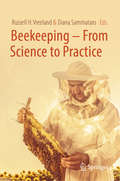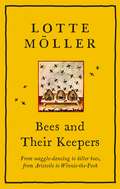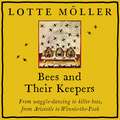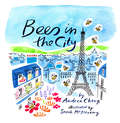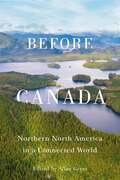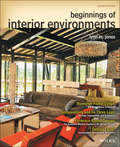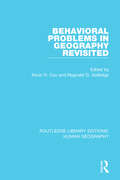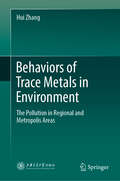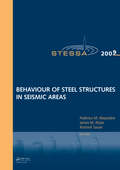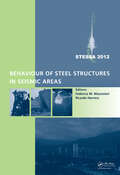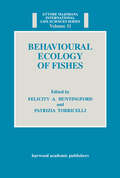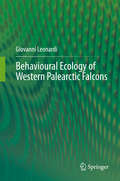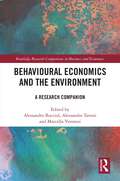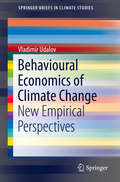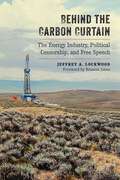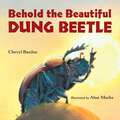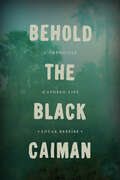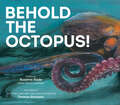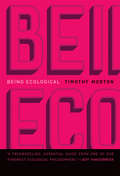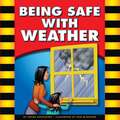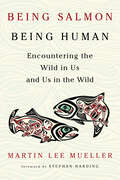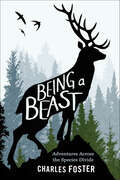- Table View
- List View
Beekeeping – From Science to Practice
by Diana Sammataro Russell H. VreelandThis book will help beekeepers understand the fundamentals of beekeeping science. Written in plain and accessible language by actual researchers, it should be part of every beekeeper's library. The respective chapters not only present raw data; they also explain how to read and understand the most common figures. With topics ranging from honeybee nutrition to strains of Varroa resistant bees, from the effects of pesticide chemicals to understanding diseases, and including a discussion of venom allergies, the book provides essential "knowhow" that beekeepers will benefit from every time they inspect their hives. Further, each chapter ends with the author explaining how beekeepers can (or cannot) directly utilize the information to enhance their beekeeping operation. The text is structured to facilitate ease of use, with each author addressing the same four issues: 1) What are the specific purposes or goals of these experiments? Or more simply: what have these studies taught us? 2) How should a non-scientist read the data generated? 3) What are the key points in relation to practicing beekeepers' goals? 4) How can the data or techniques discussed be applied by beekeepers in their own apiaries? This approach allows readers to look up specific information quickly, understand it and even put it to use without having to read entire chapters. Further, the chapters are highly readable and concise. As such, the book offers a valuable guide and faithful companion for all beekeepers, one they can use day in and day out.
Bees and Their Keepers: From waggle-dancing to killer bees, from Aristotle to Winnie-the-Pooh
by Lotte MöllerA beautifully illustrated and thoroughly engaging cultural history of beekeeping - packed with anecdote, humour and enriching historical detail. The perfect gift."A charming look at the history of beekeeping, from myth and folklore to our practical relationship with bees" Gardens Illustrated"An entertaining collation of bee trivia across the millennia" Daily Telegraph* Sweden's Gardening Book of the Year 2019 * Shortlisted for the August Prize 2019 * Winner of the Swedish Book Design Award for 2019Beekeeper and garden historian Lotte Möller explores the activities inside and outside the hive while charting the bees' natural order and habits. With a light touch she uses her encyclopaedic knowledge of the subject to shed light on humanity's understanding of bees and bee lore from antiquity to the present. A humorous debunking of the myths that have held for centuries is matched by a wry exploration of how and when they were replaced by fact. In her travels Möller encounters a trigger-happy Californian beekeeper raging against both killer bees and bee politics, warring beekeepers on the Danish island of Læso, and Brother Adam of Buckfast Abbey, breeder of the Buckfast queen now popular throughout Europe and beyond, as well a host of others as passionate as she about the complex world of apiculture both past and present.Translated from the Swedish by Frank Perry
Bees and Their Keepers: From waggle-dancing to killer bees, from Aristotle to Winnie-the-Pooh
by Lotte MöllerWith deep knowledge and a sharp wit, Lotte Möller unfolds our understanding of bees and bee lore from antiquity to the present. A beekeeper herself, she gives insight into the activity in the hive and describes the bees' natural order and habits. She explores the myths of the past, and how and when they were replaced by fact. For example, the heated discussions that broke out in the eighteenth century when it was discovered that the hive was ruled by a queen, not a king as had been the belief since Aristotle. In her travels Möller encounters a host of colourful characters, from a trigger-happy Californian beekeeper raging against both killer bees and bee politics, to the warring beekeepers on the island of Læso and Brother Adam of Buckfast Abbey, breeder of the Buckfast queen now popular throughout Europe and beyond. Bees and Their Keepers is a compelling cultural history for the beekeeper and general reader alike.Translated from the Swedish by Frank Perry(P)2020 Quercus Editions Limited
Bees in the City
by Andrea Cheng Sarah McMenemy2018 Green Earth Book Award Finalist Lionel lives in a Paris apartment building but loves keeping bees with his Aunt Celine at her farm outside the city. But when her bees start dying, how can he help? The solution, he realizes, is in the rooftop gardens and window boxes of his apartment neighbors, representing a varied and continuously blooming array of flowers that the bees will love. Aunt Celine must bring her bees to Paris! But first he and his friends Alice and Samir must convince their skeptical neighbors and landlord, Mr. Dubi, that this is a good idea. Adorned with Parisian skylines, Bees in the City is a love letter to the City of Light and a celebration of the can-do spirit of kids. Sarah McMenemy’s illustrations recall the Parisian magic of Madeleine. The book’s backmatter explores urban beekeeping and rooftop gardening in greater depth. Fountas & Pinnell Level P
Before Canada: Northern North America in a Connected World (McGill-Queen's Studies in Early Canada / Avant le Canada #8)
by Allan GreerLong before Confederation created a nation-state in northern North America, Indigenous people were establishing vast networks and trade routes. Volcanic eruptions pushed the ancestors of the Dene to undertake a trek from the present-day Northwest Territories to Arizona. Inuit migrated across the Arctic from Siberia, reaching Southern Labrador, where they met Basque fishers from northern Spain.As early as the fifteenth century, fishing ships from western Europe were coming to Newfoundland for cod, creating the greatest transatlantic maritime link in the early modern world. Later, fur traders would take capitalism across the continent, using cheap rum to lubricate their transactions. The contributors to Before Canada reveal the latest findings of archaeological and historical research on this fascinating period. Along the way, they reframe the story of the Canadian past, extending its limits across time and space and challenging us to reconsider our assumptions about this supposedly young country.Innovative and multidisciplinary, Before Canada inspires interest in the deep history of northern North America.
Before It's Gone: Stories from the Front Lines of Climate Change in Small-Town America
by Jonathan VigliottiFrom CBS News national correspondent Jonathan Vigliotti, a &“vivid&” (Elizabeth Kolbert, Pulitzer Prize–winning author) and &“stunning&” (Booklist) character-driven call to action on our climate, told through the stories of the pioneering Americans working to persevere as leadership inaction risks the very survival of our heartland and hometowns.Discussion of the climate crisis has always suffered from a problem of abstraction. Data points and warnings of an overheated future struggle to break through the noise of everyday life. Deniers often portray climate solutions as inconvenient, expensive, and unnecessary. And many politicians, cloistered by status and focused always on their next election, do not yet see climate as a winning issue in the short run, so they don&’t take any action at all. But climate change, and its devastating consequences, has kept apace whether we want to pay attention or not. CBS News national correspondent Jonathan Vigliotti has seen that crisis unfold for himself, spending nearly two decades reporting across the United States (and the world) documenting the people, communities, landmarks, and traditions we&’ve already surrendered. Vigliotti shares with urgency and personal touch the story of an America on the brink. Before It&’s Gone traces Vigliotti&’s travels across the country, taking him to the frontlines of climate disaster and revealing the genuine impacts of climate change that countless Americans have already been forced to confront. From massive forest fires in California to hurricanes in Louisiana, receding coastlines in Massachusetts and devastated fisheries in Alaska, we learn that warnings of a future impacted by climate are no more; the climate catastrophe is already here. This is the story of America, and Americans, on the edge, and a powerful argument that radical action on climate change with a respect for its people and traditions is not only possible, but also the only way to preserve what we love.
Beginnings of Interior Environments (Fashion Ser.)
by Lynn M. Jones Heidi PlumbThe new edition of the leading textbook remains the gold standard for interior design education. In this twelfth edition of Beginnings of Interior Environments, established interior designer and professor Lynn M. Jones, ASID, IDEC collaborates with innovator Heidi Plumb, IIDA, IDEC, to deliver a practical and balanced overview of commercial and residential interior design. Written to offer coverage of the creative and technical characteristics of the profession, the text also addresses Council for Interior Design Accreditation (CIDA) content. Part I opens with a discussion on the scope and value of the profession and includes a pictorial overview of the history of design. Subsequent parts cover design fundamentals, the spatial envelope—including space planning and systems—, products and materiality, and designing for a living. A new chapter addresses the art and science of visual communications. Hundreds of images from actual design projects, supplied by national and international design firms, illustrate quality examples. &“Precedent Studies&” include in-house production work from these practicing designers. Content, updated throughout, includes additional information on design thinking, inclusivity, WELL building standards, casework, and architectural millwork. New end-of-chapter self-directed projects provide students the opportunity to apply their knowledge. Written by two successful educators and practitioners, both NCIDQ certified with terminal degrees, the text applies a balance between education and practice. It is the ideal textbook for introductory interior design or interior architecture courses, and an invaluable resource for anyone looking to apply a holistic interior design perspective to their own home or business. As in previous editions, the text Introduces interior design with a foundation in its health, safety, and welfare benefits Explores design fundamentals, including visual literacy, and the elements and principles of design, with a special emphasis on color and now visual communications Discusses construction, including building components, codes, regulations, as well as lighting, electrical, and communication systems Offers an in-depth examination of the profession, including career pathways and professional organizations Reviews critical global issues such as sustainability, universal design, and culturally sensitive design Includes a dedicated section on interior materials and finishes—floorings, ceilings, wallcoverings, upholstery—and furnishings such as furniture, art, and accessories Leads students to analyze the needs of clients to design safe and sustainable environments that enhance the quality of life Includes a companion site for instructors featuring PowerPoint slides and an Instructor's manual with discussion points, objectives, lecture outlines, learning activities, and example quizzes with answers
Beginnings of Interior Environments (Fashion Ser.)
by Lynn M. JonesThe gold standard for entry-level interior design education, now published by Wiley In this Eleventh Edition of Beginnings of Interior Environments, accomplished interior designer and professor Lynn M. Jones delivers a balanced and comprehensive overview of commercial and residential interior design. Written to offer coverage of the creative and technical characteristics of the profession, the text also addresses Council for Interior Design Accreditation (CIDA) content. The book presents topics on the scope of the profession, spatial development, and visual literacy while also reviewing the factors of quality aesthetics. Hundreds of images from actual design projects, supplied by national and international design firms, illustrate the design process. “Design Scenarios,” or case studies, demonstrate examples of professional practice and in-house production work students are likely to encounter during their career. The text discusses issues of global importance, from sustainability to universal design; a pictorial essay reviews the history of style. Readers will also enjoy: An introduction to interior environments, including the fundamentals of interior design and the health, safety, and welfare benefits of interior design An exploration of design fundamentals, including the elements and principles of design, with a special emphasis on color Practical discussions on building construction, including construction components and codes, as well as lighting, electrical, and communication systems An entire section dedicated to interior finishes—upholstery, wallcoverings, and floorings—and furnishings—furniture, art, and accessories In-depth examinations of the profession of interior design, including career opportunities Beginnings of Interior Environments is perfect for students in an introductory interior design course, and an indispensable resource for anyone seeking a balanced interior design perspective for their home or office.
Behavioral Ecology and the Transition to Agriculture
by Douglas J. Kennett Bruce WinterhalderThis innovative volume is the first collective effort by archaeologists and ethnographers to use concepts and models from human behavioral ecology to explore one of the most consequential transitions in human history: the origins of agriculture. Carefully balancing theory and detailed empirical study, and drawing from a series of ethnographic and archaeological case studies from eleven locations--including North and South America, Mesoamerica, Europe, the Near East, Africa, and the Pacific--the contributors to this volume examine the transition from hunting and gathering to farming and herding using a broad set of analytical models and concepts. These include diet breadth, central place foraging, ideal free distribution, discounting, risk sensitivity, population ecology, and costly signaling. An introductory chapter both charts the basics of the theory and notes areas of rapid advance in our understanding of how human subsistence systems evolve. Two concluding chapters by senior archaeologists reflect on the potential for human behavioral ecology to explain domestication and the transition from foraging to farming.
Behavioral Problems in Geography Revisited (Routledge Library Editions: Human Geography #6)
by Kevin R Cox Reginald GolledgeThis collection of papers, originally published in 1981, reviews and evaluates past and possible future advances in a field of central importance to human geography: behavioral geography. The book includes critical studies which show how the approach has contributed substantially to work within four areas of amjor application in behavioral geography: urban travel behavior, environmental cognition, residential mobility and spatial diffusion. The final section of the book focuses on the shortcomings of the behavioral approach and considers the alternative modes of analysis available.
Behaviors of Trace Metals in Environment: The Pollution in Regional and Metropolis Areas
by Hui ZhangThis book focuses on the behavior and impact of trace metals in the environment by studying typical cases from China such as the Hetao Area of the Yellow River, Shanghai, and Nanjing. Based on samples and experiments on the behavior of pollutants, it systematically discusses the regulation of trace metals’ distribution, accumulation, and migration, associated with the cause of formation demonstration. The author subsequently uses the acquired data to review the evolving trend of trace metal behaviors in natural systems (river or lake water, sediments, and soils), develops suggestions for the prevention of their negative effects, and devise treatments. Moreover, he proposes solutions to difficult research issues such as trace metal speciation extraction, and an analysis, along with operational procedures. Given its scope, the book will provide a valuable guide for researchers and engineers in relevant disciplines of the environmental sciences and engineering, and for environmental policymakers to consult in practices.
Behaviour of Steel Structures in Seismic Areas: STESSA 2009
by Federico M. Mazzolani James M. Ricles Richard SauseBehaviour of Steel Structures in Seismic Areas comprises the latest progress in both theoretical and experimental research on the behaviour of steel structures in seismic areas. The book presents the most recent trends in the field of steel structures in seismic areas, with particular reference to the utilisation of multi-level performance bas
Behaviour of Steel Structures in Seismic Areas: STESSA 2012
by Federico Mazzolani Ricardo HerreraBehaviour of Steel Structures in Seismic Areas is a comprehensive overview of recent developments in the field of seismic resistant steel structures. It comprises a collection of papers presented at the seventh International Specialty Conference STESSA 2012 (Santiago, Chile, 9-11 January 2012), and includes the state-of-the-art in both theore
Behavioural Ecology of Fishes
by Felicity Anne HuntingfordThis discipline of behavioural ecology has reached a turning point- empirical evidence in behavioural ecology has led to the reformulation of the classic explanatory theories, and new areas of interest have opened up. The study of fish provides an excellent model of the subject, allowing a concise but complete treatment of the field. This book is based on papers from the proceedings of a conference held at the Ettore Majorana Centre, Erice, Italy, provides an overview of the key developments in behavioural ecology. Four main areas of interest are covered the behavioural ecology of predator avoidance, foraging, resource defence and life histories and reproduction.
Behavioural Ecology of Western Palearctic Falcons
by Giovanni LeonardiThis monograph is the result of eight years of bibliographical and field research concerning several behavioural ecology aspects of the Palaearctic falcons. For a while, this book grew along with “The Lanner falcon” published in 2015 and revised in 2017. In both books the main aim was to provide a clear overview of the biology and ecology of these species. In fact in the last 20 years, the number of publications on falcons has grown tremendously and, in parallel, also those belonging to the so-called "grey literature". The number of people involved is also increased by including both academics and nature lovers. Many previously published books emphasized identification, and offered little insights on the behavioural and ecological aspects of the species. Very often, the research on behavioural ecology remains closed within the confines of academic community. By contrast, a multitude of basic data is scattered in countless articles published in local magazines. Many falcon species are easy to observe and study (such as kestrels) but others are more rare and localized. In order to understand the survival strategies adopted by this group of avian predators, it is necessary not to lose sight of the overall picture. This book tries to explain the different survival strategies by examining, through a few essential chapters, some crucial aspects for all species. The first chapter provides information on the genus Falco, its genetics, evolution and morphological peculiarities. The other chapters deal with reproductive strategies, competition, exploitation of resources, dispersal patterns, communication and sociality. One of the main objectives of this book is to produce an accessible but scholarly curated source of reference. By understanding the most common species, it is possible to provide a working framework for rarer, and especially threatened, falcon species.
Behavioural Economics and the Environment: A Research Companion (Routledge Research Companions in Business and Economics)
by Alessandro BucciolHumans have long neglected to fully consider the impact of their behaviour on the environment. From excessive consumption of fossil fuels and natural resources to pollution, waste disposal, and, in more recent years, climate change, most people and institutions lack a clear understanding of the environmental consequences of their actions. The new field of behavioural environmental economics seeks to address this by applying the framework of behavioural economics to environmental issues, thereby rationalizing unexplained puzzles and providing a more realistic account of individual behaviour. This book provides a complete and rigorous overview of environmental topics that may be addressed and, in many instances, better understood by integrating a behavioural approach. This volume features state-of-the-art research on this topic by influential scholars in behavioural and environmental economics, focussing on the effects of psychological, social and cognitive factors on the decision-making process. It presents research performed using different methods and data collection mechanisms (e.g. laboratory experiments, field experiments, natural experiments, online surveys) on a variety of environmental topics (e.g. sustainability, natural resources). This book is a comprehensive and innovative tool for researchers and students interested in the behavioural economics of the environment and in the design of policy interventions aimed at reducing the human impact on the environment.
Behavioural Economics of Climate Change: New Empirical Perspectives (Springerbriefs In Climate Studies)
by Vladimir UdalovThis book investigates various kinds of climate change mitigation behaviour, which range from a general support of environmental policy to concrete energy-saving activities, in selected countries. Drawing on extensive national and international survey data, the analysis has the following main objectives: to identify potential determinants of individuals’ renewable energy support, and to analyse the impact of experiences with natural disasters on individuals’ choice between economic growth and environmental protection. Moreover, it examines the role of environmental motivations behind direct daily energy-saving behaviour. The empirical results reveal that various types of climate change mitigation behaviour are not only driven by a mixture of environmental and non-environmental/economic motivations but also depend on external circumstances such as natural disasters. Since CO2 emission dynamics stem to some extent from the choices people make every day in their roles as consumers, investors and citizens, the new findings presented are also valuable from a policy perspective.
Behind the Carbon Curtain: The Energy Industry, Political Censorship, and Free Speech
by Jeffrey A. LockwoodExploring censorship imposed by corporate wealth and power, this book focuses on the energy industry in Wyoming, where coal, oil, and gas are pillars of the economy. The author examines how governmental bodies and public institutions have suppressed the expression of ideas that conflict with the financial interests of those who profit from fossil fuels. He reveals the ways in which university administrations, art museums, education boards, and research institutes have been coerced into destroying artwork, abandoning studies, modifying curricula, and firing employees. His book is an eloquent story of the conflict between private wealth and free speech.Providing more of the nation&’s energy than any other state, Wyoming is a sociopolitical lens that magnifies the conflicts in the American West. But the issues are relevant to any community that is dependent on a dominant industry—and wherever the liberties of citizens and the ethics of public officials are at risk.
Behold the Beautiful Dung Beetle
by Cheryl BardoeDung is a precious pile of food and drink for these beetles.Simple science text and dramatic illustrations give a close-up view of the fascinating world of the dung beetle. When an animal lightens its load, dung beetles race to the scene. They battle over, devour, hoard, and lay their eggs in the precious poop. Dung is food, drink, and fuel for new life—as crucial to these beetles as the beetles are to many habitats, including our own.Back matter includes instructions for finding dung beetles, fun facts, glossary, and a selected bibliography.
Behold the Black Caiman: A Chronicle of Ayoreo Life
by Lucas BessireIn 2004, one of the world’s last bands of voluntarily isolated nomads left behind their ancestral life in the dwindling thorn forests of northern Paraguay, fleeing ranchers’ bulldozers. Behold the Black Caiman is Lucas Bessire’s intimate chronicle of the journey of this small group of Ayoreo people, the terrifying new world they now face, and the precarious lives they are piecing together against the backdrop of soul-collecting missionaries, humanitarian NGOs, late liberal economic policies, and the highest deforestation rate in the world. Drawing on ten years of fieldwork, Bessire highlights the stark disconnect between the desperate conditions of Ayoreo life for those out of the forest and the well-funded global efforts to preserve those Ayoreo still living in it. By showing how this disconnect reverberates within Ayoreo bodies and minds, his reflexive account takes aim at the devastating consequences of our society’s continued obsession with the primitive and raises important questions about anthropology’s potent capacity to further or impede indigenous struggles for sovereignty. The result is a timely update to the classic literary ethnographies of South America, a sustained critique of the so-called ontological turn—one of anthropology’s hottest trends—and, above all, an urgent call for scholars and activists alike to rethink their notions of difference.
Behold the Octopus!
by Suzanne SladeLyrical text and gorgeous illustrations plunge readers into an undersea exploration of the mysterious, accomplished octopus and its astonishing abilities.Behold the octopus! This remarkable animal hides beneath the seas, so you may not realize that it is one of the most incredible, talented creatures on our planet.Fortunately, this nonfiction picture book from an award-winning team reveals the fascinating features of the glorious octopus, such as lights that attract prey, legs that walk on land, and the ability to change color and shape to match their surroundings and even masquerade as other animals.Sparse, lyrical text is perfect for curious picture book readers, while sidebars and back matter share additional interesting details.
Being Ecological (The\mit Press Ser.)
by Timothy MortonA book about ecology without information dumping, guilt inducing, or preaching to the choir.Don't care about ecology? You think you don't, but you might all the same. Don't read ecology books? This book is for you. Ecology books can be confusing information dumps that are out of date by the time they hit you. Slapping you upside the head to make you feel bad. Grabbing you by the lapels while yelling disturbing facts. Handwringing in agony about “What are we going to do?” This book has none of that. Being Ecological doesn't preach to the eco-choir. It's for you—even, Timothy Morton explains, if you're not in the choir, even if you have no idea what choirs are. You might already be ecological.After establishing the approach of the book (no facts allowed!), Morton draws on Kant and Heidegger to help us understand living in an age of mass extinction caused by global warming. He considers the object of ecological awareness and ecological thinking: the biosphere and its interconnections. He discusses what sorts of actions count as ecological—starting a revolution? going to the garden center to smell the plants? And finally, in “Not a Grand Tour of Ecological Thought,” he explores a variety of current styles of being ecological—a range of overlapping orientations rather than preformatted self-labeling. Caught up in the us-versus-them (or you-versus-everything else) urgency of ecological crisis, Morton suggests, it's easy to forget that you are a symbiotic being entangled with other symbiotic beings. Isn't that being ecological?
Being Safe with Weather
by Susan KesselringThis fun, colorful book describes basic rules for what to do and what not to do to be safe in inclement weather. Picture descriptions present.
Being Salmon, Being Human: Encountering the Wild in Us and Us in the Wild
by Martin Lee MuellerNautilus Award Silver Medal Winner, Ecology & Environment In search of a new story for our place on earthBeing Salmon, Being Human examines Western culture&’s tragic alienation from nature by focusing on the relationship between people and salmon―weaving together key narratives about the Norwegian salmon industry as well as wild salmon in indigenous cultures of the Pacific Northwest.Mueller uses this lens to articulate a comprehensive critique of human exceptionalism, directly challenging the four-hundred-year-old notion that other animals are nothing but complicated machines without rich inner lives and that Earth is a passive backdrop to human experience. Being fully human, he argues, means experiencing the intersection of our horizon of understanding with that of other animals. Salmon are the test case for this. Mueller experiments, in evocative narrative passages, with imagining the world as a salmon might see it, and considering how this enriches our understanding of humanity in the process.Being Salmon, Being Human is both a philosophical and a narrative work, rewarding readers with insightful interpretations of major philosophers―Descartes, Heidegger, Abram, and many more―and reflections on the human–Earth relationship. It stands alongside Abram&’s Spell of the Sensuous and Becoming Animal, as well as Andreas Weber&’s The Biology of Wonder and Matter and Desire―heralding a new &“Copernican revolution&” in the fields of biology, ecology, and philosophy.&“Philosophically, scientifically, morally, and artistically, Mueller blows the [salmon] industry guys literally out of the water. If you care about the future of salmon, you must read this essential, rigorously documented book.&”―Sy Montgomery, coauthor of Tamed and Untamed; author of The Soul of an Octopus&“A marvelous exploration of what it means to belong within life&’s community. Mueller integrates imagination and analysis to produce a book of rare and important insight.&”―David George Haskell, author of The Songs of Trees
Being a Beast: Adventures Across the Species Divide
by Charles FosterA passionate naturalist explores what it’s really like to be an animal—by living like themHow can we ever be sure that we really know the other? To test the limits of our ability to inhabit lives that are not our own, Charles Foster set out to know the ultimate other: the non-humans, the beasts. And to do that, he tried to be like them, choosing a badger, an otter, a fox, a deer, and a swift. He lived alongside badgers for weeks, sleeping in a sett in a Welsh hillside and eating earthworms, learning to sense the landscape through his nose rather than his eyes. He caught fish in his teeth while swimming like an otter; rooted through London garbage cans as an urban fox; was hunted by bloodhounds as a red deer, nearly dying in the snow. And he followed the swifts on their migration route over the Strait of Gibraltar, discovering himself to be strangely connected to the birds. A lyrical, intimate, and completely radical look at the life of animals—human and other—Being a Beast mingles neuroscience and psychology, nature writing and memoir to cross the boundaries separating the species. It is an extraordinary journey full of thrills and surprises, humor and joy. And, ultimately, it is an inquiry into the human experience in our world, carried out by exploring the full range of the life around us.
